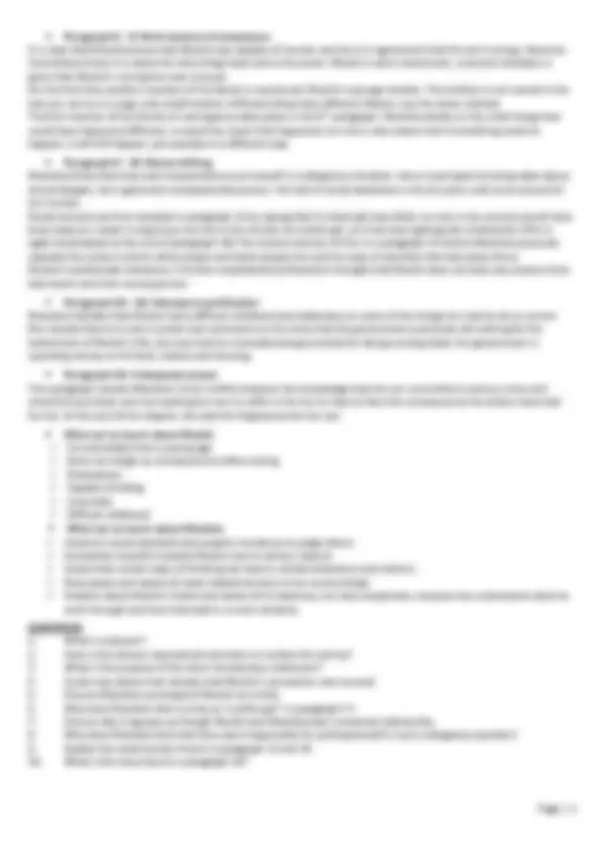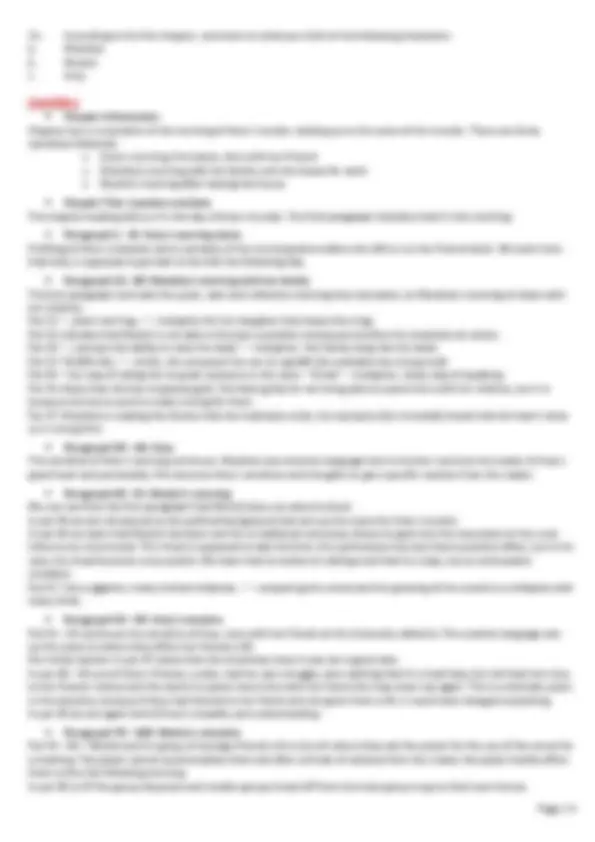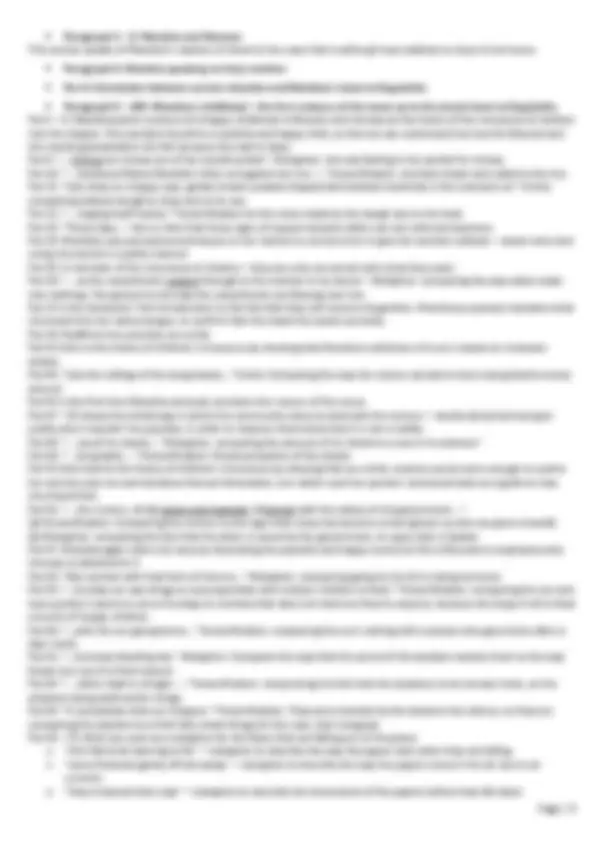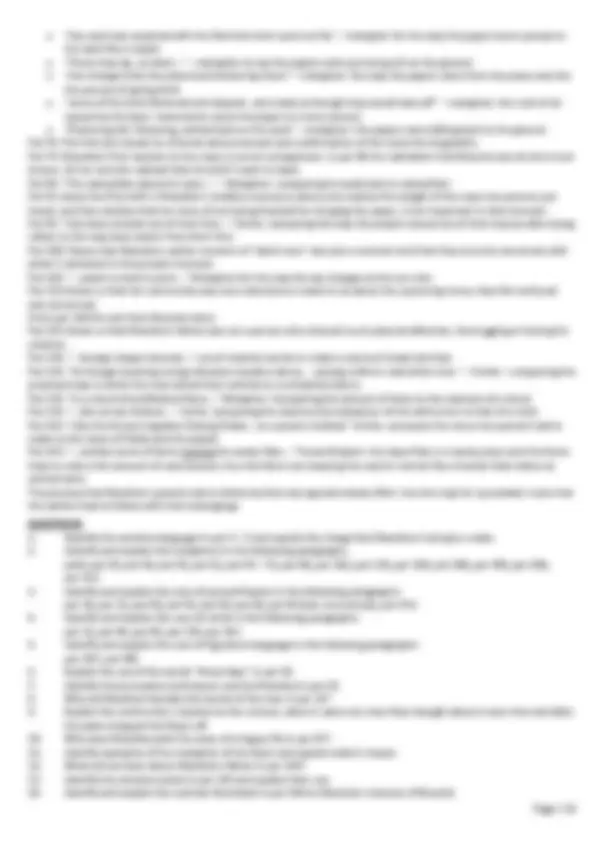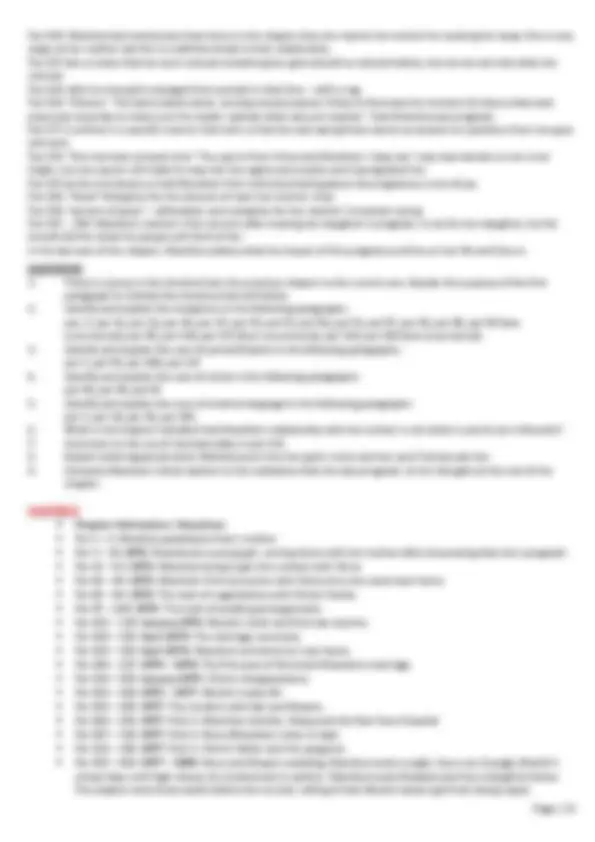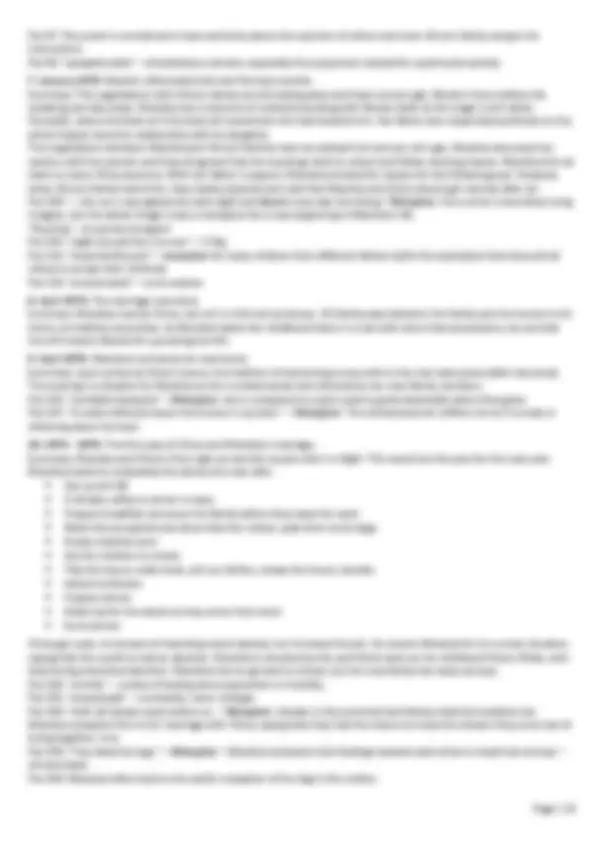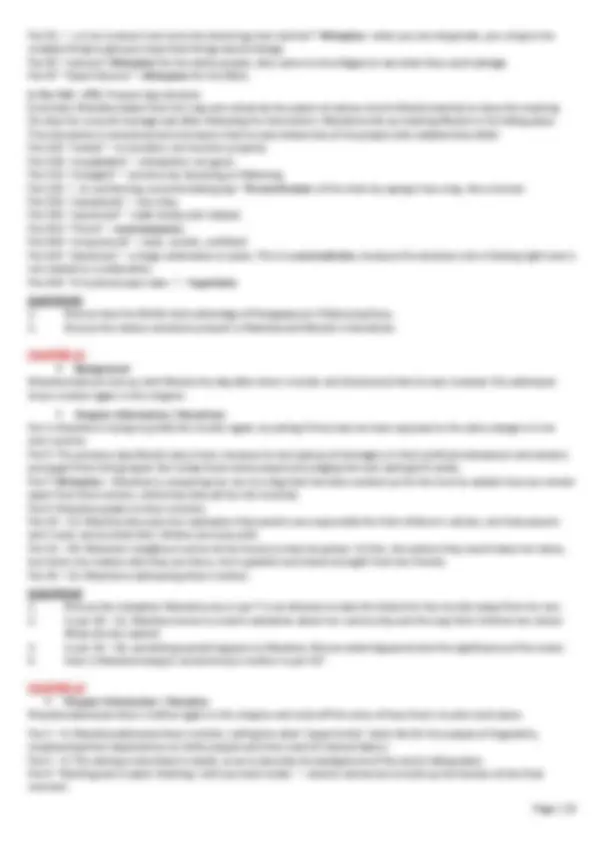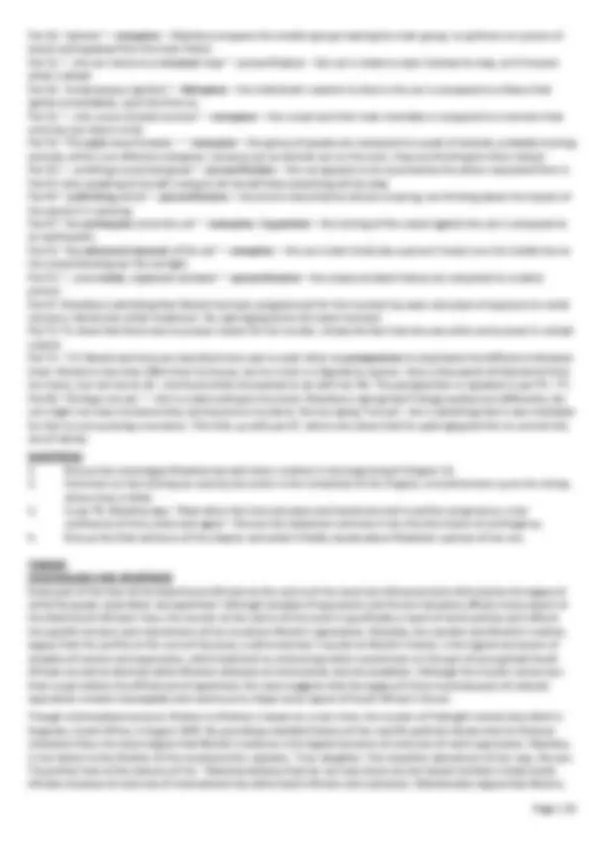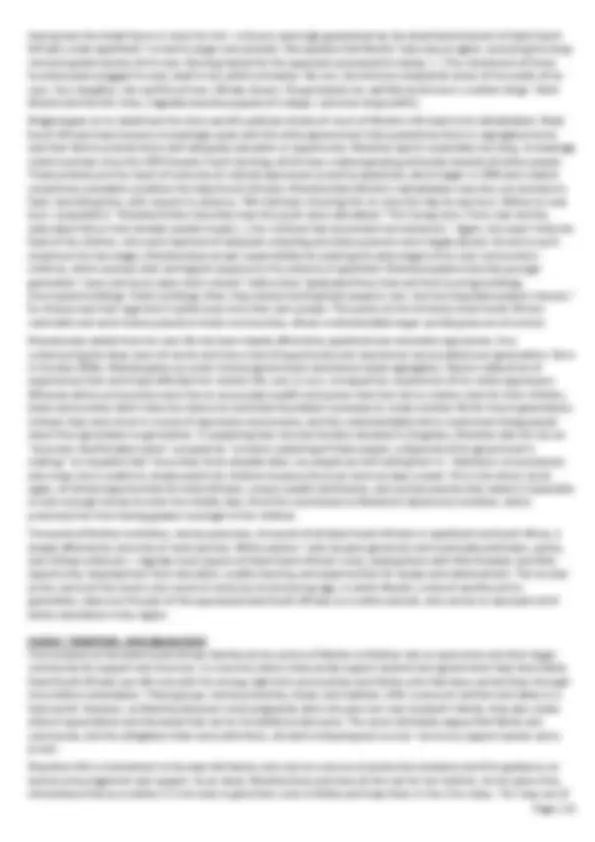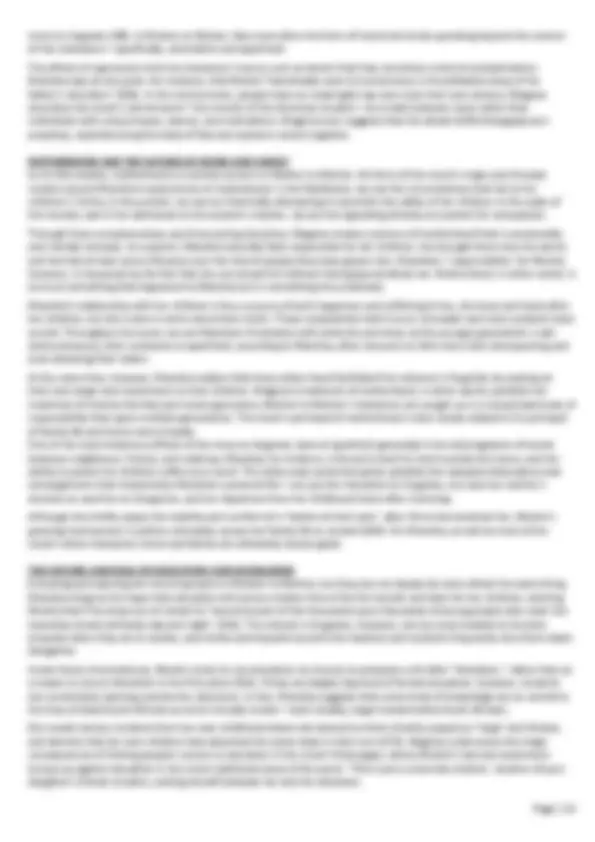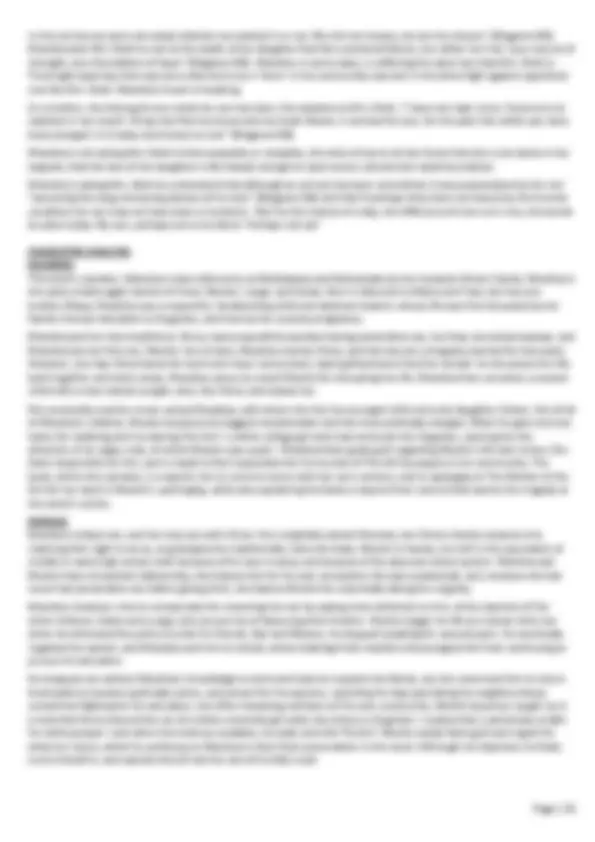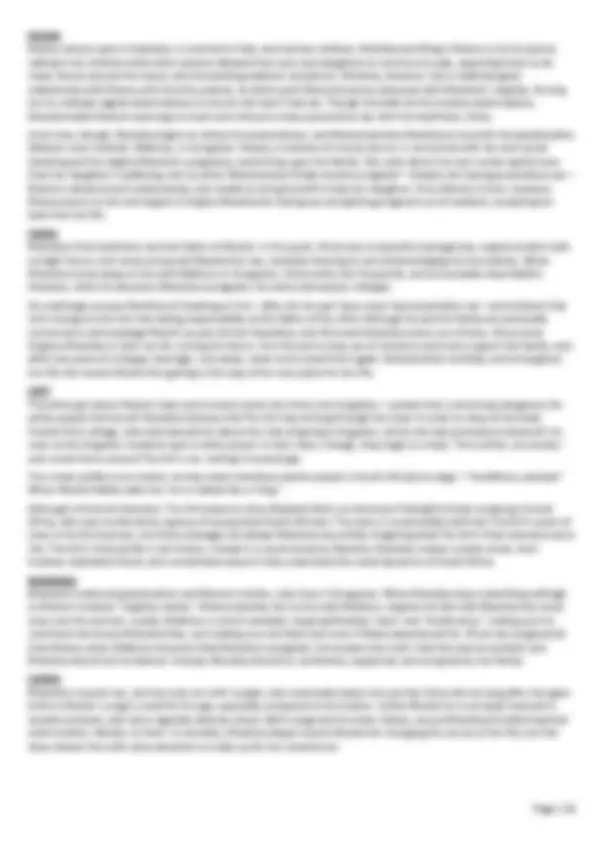Download Mother-to-Mother-Study-Guide-V2-2020.pdf and more Study notes Law in PDF only on Docsity!
MOTHER TO MOTHER STUDY GUIDE
BRIEF BIOGRAPHY OF SINDIWE MAGONA
Sindiwe Magona was born in Umtata, a town in eastern South Africa, and grew up in Guguletu, a township outside of Cape Town. She attended primary school in Guguletu, but finished high school through a correspondence course. She then received a bachelor’s degree from the University of South Africa, and in 1981 moved to New York to work on a master’s degree in Social Work. In between, she did domestic work and worked as a schoolteacher. After receiving her master’s degree, Magona worked for the United Nations, first working in radio and then in the Public Information department until retiring to Cape Town, her home, in 2003. Magona wrote throughout her life, spending her earlier years writing autobiographical prose, short stories, and novels, and beginning to explore children’s literature in her retirement. HISTORICAL CONTEXT OF MOTHER TO MOTHER Portuguese traders first began to explore the coastline of South Africa in the 1400s, but Europeans didn’t begin to colonize the area until 1600s, when the Dutch East India Company created permanent settlements at what is now Cape Town. The settlements were a port to help passing ships on their way to Asia, but colonization expanded as greater infrastructure was required to serve said ships. Over time, the colony expanded along the coast and inland, with white colonists killing and enslaving (or forcing into indentured servitude) black Africans as they encountered them. Eventually British settlers also arrived, initially only interested in the Cape as a strategic port, but eventually going to war against Boers (or Dutch South Africans), officially taking control of South Africa in 1909. As long as white Europeans had been in South Africa, black Africans were forced to endure racism and discrimination. This was formally written into law in the mid 1880s, and further formalized in 1948—the beginning of the fifty year apartheid which denied civil and human rights to all black South Africans. INTRODUCTION OF CHARACTERS MAIN CHARACTERS:
- Mandisa Ntloko – Mother of Mxolisi and first person narrator
- Mxolisi – Son of Mandisa, involved in the killing of Amy Biehl, AKA Boyboy, Michael, Hlumelo)
- Amy Biehl – not part of the active storyline, but present in flashbacks, killed by a group of black teenagers, amongst others, Mxolisi SECONDARY CHARACTERS:
- China – married (traditionally only) to Mandisa, father of Mxolisi, but not present in the active storyline.
- Lungile – unmarried partner of Mandisa, one son (Lungisa)
- Dwadwa – husband of Mandisa, father of Siziwe
- Tata – Mandisa’s father
- Mama – Mandisa’s mother
- Tatomkhulu – Mandisa’s grandfather (Tata’s father)
- Makhulu – Mandisa’s grandmother (Tata’s mother)
- Mzamo and Zazi – friends of Mxolisi while he is still a small boy
- Aunty Funiwe – Mandisa’s aunt, Mama’s younger sister
- Khaya – Mandisa’s brother, married to Nono
- Nono – Mandisa’s school friend, married to her brother
SUMMARY
Mother to Mother weaves back and forth in time, covering the narrator, Mandisa’s life from her early childhood, through the birth of her children, through her son, Mxolisi’s murder of the Girl, a white American driving through their township of Guguletu. This is interspersed with The Girl, Mandisa, and Mxolisi’s experiences on the day of the murder, and the morning after. The novel also includes interludes in which Mandisa addresses the Mother of the Girl, asking rhetorical questions about the Girl’s life and upbringing, expressing her grief for the Girl’s death, and attempting to explain—but not justify— Mxolisi’s actions. Chronologically, the novel begins with Mandisa’s childhood. She and her brother, Khaya, were raised in Blouvlei, but were forced to relocate to Guguletu by the South African government. This derailed the educations of many students, although Mandisa and Khaya were able to remain in school for a while, at least until Khaya impregnated his girlfriend, Nono, and Mandisa became accidentally pregnant through non-penetrative sex with her boyfriend, China. Mama, Mandisa’s mother, is furious with her daughter, feeling that her pregnancy will embarrass the whole family, but eventually comes to love Mandisa and her newborn son. Mandisa’s parents force her to marry China, who is no longer interested in her romantically, and the two lived together unhappily for two years, until one day China runs away and disappears forever. Mandisa then moves into a hokkie of her own and does her best to raise Mxolisi, eventually having another child, Lunga, with a man named Lungile, and finally marrying a man, Dwadwa, with whom she has her youngest child and only daughter, Siziwe. Mandisa recounts Mxolisi’s childhood. A talkative precocious boy, he stops talking for several years after witnessing the death of two older boys, Zazi and Mzamo. He regains his speech, but during his silence Mandisa realizes the resentment she feels for him, for interrupting her life with an unplanned pregnancy, and dramatically changing the course of her future. As Mxolisi gets older he becomes involved in youth political movements, like the Young Lions. Increasingly radicalized and violent, this group burns cars, buildings, and even kills black South Africans around their township. On the day of the tragedy, Amy is driving some of her black South African friends home from their university, when Mxolisi and others spot her in her car. A group of men converge, chasing her from the car, but Mxolisi is the man to stab and kill her. Mandisa discovers this later, spending the first night after the murder anxiously wondering if her son, who has not returned home, was somehow involved. A late night police raid of Mandisa’s house furthers her suspicions. In the morning, Reverend Mananga stops by and gives Mandisa vague instructions for how to see her son. She follows them and is briefly reunited with Mxolisi, whom she comforts and who comforts her, before he (presumably though not explicitly) turns himself in to the police. CHAPTER 1
- Chapter Title: Mandisa’s Lament A lament is an expression of extreme sadness or grief. Mandisa’s grief is presented as a letter written by her (as the mother of Mxolisi) to the mother of Amy Biehl, the American student who was killed by Mxolisi and a group of black teenagers.
- Introductory sentence: “My son killed your daughter” A shocking statement, it immediately captures the interest of the reader and lets the reader know who the letter is written to (Amy’s mother) and by (Mandisa, Mxolisi’s mother).
- Paragraph 1: Mandisa’s emotional status People’s judgement of her son makes Mandisa feel as though she has some part in his actions. The piece indicates that Mxolisi has been difficult from a young age – in fact, from his conception. This is the first indication that his conception was unusual.
- Paragraph 2 – 5: Sarcasm (as a coping mechanism) Mandisa keeps her thoughts busy by sarcastically reviewing the events in her head, should she have encouraged Mxolisi to kill Amy. She does this to reassure herself that people are being unfair towards her. By initially referring to Amy as “a white girl” depersonalises Amy and turns her into any white female of her age. The sharp comment “where she does not belong” is Mandisa’s attempt at shifting some of the blame from Mxolisi to Amy. We can also tell from her sarcastic tone that Mxolisi would typically not think before acting. In paragraph 4 we see the first indication that the relationship between Mandisa and Mxolisi is strained. In paragraph 5 she appears exasperated and again portrays Mxolisi as behaviourally difficult.
- According to the first chapter, comment on what you think of the following characters: a. Mandisa b. Mxolisi c. Amy CHAPTER 2
- Chapter Information: Chapter two is a narrative of the morning of Amy’s murder, leading up to the scene of the murder. There are three narratives followed: o Amy’s morning, first alone, then with her friends o Mandisa’s morning with her family until she leaves for work o Mxolisi’s morning after leaving the house
- Chapter Title: Location and date The chapter heading tells us it’s the day of Amy’s murder. The first paragraph indicates that it’s the morning.
- Paragraph 1 - 11 : Amy’s morning alone Profiling of Amy’s character and a narrative of her morning alone before she left to run her final errands. We learn here that Amy is supposed to go back to the USA the following day.
- Paragraph 12 - 38 : Mandisa’s morning with her family The first paragraph contrasts the quiet, calm and reflective morning Amy had alone, to Mandisa’s morning of chaos with her children. Par 13 “…silent inert log…” – metaphor for her daughter that sleeps like a log. Par 16 indicates that Mxolisi is not able to foresee a possible consequence before he completes an action. Par 18 “…I possess the ability to raise the dead.” – metaphor. Her family sleep like the dead. Par 23 “Giraffe-like..” – simile, she compares her son to a giraffe (he probably has a long neck) Par 24 – her way of telling him to greet everyone in the room. “throw” – metaphor, sharp way of speaking. Par 35 shows that she has misplaced guilt. She feels guilty for not being able to spend time with her children, but it is because she has to work to make a living for them. Par 37: Mandisa is creating the illusion that she maintains order, but everyone (her included) knows that she hasn’t done so in a long time.
- Paragraph 39 – 4 2: Amy The narrative of Amy’s morning continues. Mandisa uses emotive language here to further convince the reader of Amy’s good heart and personality. She assumes Amy’s emotions and thoughts to get a specific reaction from the reader.
- Paragraph 43 - 51 : Mxolisi’s morning We can see from the first paragraph that Mxolisi does not attend school. In par 44 we are introduced to the political background that sets up the scene for Amy’s murder. In par 45 we learn that Mxolisi has been sent for a traditional ceremony where he goes into the mountains to the rural tribes to be circumcised. This ritual is supposed to take the form of a spiritual journey and have a positive effect, but in his case, the ritual has been unsuccessful. We learn that he bullies his siblings and that he is lazy, but an enthusiastic socializer. Par 51 “Like a gigantic, many-limbed millipede…” – comparing the crowd and the growing of the crowd to a millipede with many limbs.
- Paragraph 52 – 69 : Amy’s storyline Par 52 – 56 continues the narrative of Amy, here with her friends at the University cafeteria. The emotive language sets up the scene to where Amy offers her friends a lift. Her initial reaction in par 57 shows that she intuitively knew it was not a good idea. In par 60 – 64 one of Amy’s friends, Lumka, had her own struggle, also realising that it’s a bad idea, but she feels torn due to her friends’ silence and the desire to spend more time with her friend she may never see again. This is a dramatic point in the storyline, because if Amy had listened to her friend and not given them a lift, it could have changed everything. In par 65 we are again told of Amy’s empathy and understanding.
- Paragraph 70 – 105: Mxolisi’s storyline Par 70 – 84 – Mxolisi and his group of teenage friends visit a church where they ask the pastor for the use of the venue for a meeting. The pastor cannot accommodate them and after a threat of violence from the crowd, the pastor hastily offers them a time the following morning. In par 85 to 87 the group disperses and smaller groups break off from the main group to go to their own homes.
In par 88 – 99 the group come across a burning car, set alight as part of the area’s riots. The driver of the car has run off to save his own life. Police arrive on the scene and the group disperses. It is clear that the group’s reactions have gone beyond reasonable as they are now destroying their own resources to express their anger. The scene of the burning car adds to the underlying tension that the writer is building up throughout the chapter. In paragraph 100 – 105 the main group again breaks off and the remaining group is moving closer to the scene where the murder will take place, singing struggle songs. They were obviously out looking for whatever trouble they could find, as can be seen from par 105.
- Paragraph 106 – 110: Amy’s storyline The writer takes us back to Amy, who is getting in her car with her friends. The mood is sombre, because it is their last time together. The sombre mood adds to the building tension.
- Paragraph 111 – 122: Mxolisi’s storyline Mxolisi’s group continues past the police station on their way home. In par 116, Amy’s car enters Gugulethu while the crowd sings a struggle song. Par 118 – 120 shows that the crowd is eager for excitement – so eager that they will create it themselves. Par 121 “The car is small.” This sentence stands alone to have impact – the car could have been missed, but the crowd saw it. Par 122 gives us an indication of how Amy’s murder started – the crowd was gathering around the car, angrily shaking their fists in the air. o What we’ve learnt about Amy:
- Happy person • Fit and strong body
- Long, thick, dark hair • Kind heart
- Good person • Deserves better
- Generous • Empathic and understanding QUESTIONS
- There are three storylines in this chapter. Which characters are being followed?
- Identify and explain the metaphors in the following paragraphs: par 13; par 18; par 24
- Comment on what you’ve learnt about Amy’s physical appearance and character traits.
- Explain the illusion that Mandisa is trying to create in par 37 and why it fails.
- Discuss the purpose of the writer’s explanation of the political background in par 44.
- Explain the ritual in par. 45.
- Explain Amy’s initial reaction when she offered her friends a lift.
- Discuss Lumka’s inner struggle in par 60 to 64 and why it is so important to the story.
- Discuss the scene of the burning car in par 88 and what we have learnt about the crowd of people that set it alight.
- Comment on the following sentence: “The car is small.” CHAPTER 3
- Chapter Information: Chapter three is a continuation of the narrative in the present (1993) and follows the following narratives: o Mandisa’s afternoon at work o Mandisa’s bus trip and walk home o Mandisa’s childhood where her family was forced to move to Gugulethu.
- Chapter Title: Location, date and time The chapter heading tells us it’s still the day of Amy’s murder, but now in the afternoon.
- Paragraph 1 – 24: Mandisa at work We meet Mandisa’s boss, Mrs Nelson, who comes home in a rush, telling Mandisa that she has to go home, earlier than usual. Par 2: Mandisa again emphasizes the segregation between black and white, by referring to Mrs Nelson as “the white woman that I work for”. Par 4 – 13 describe Mrs Nelson’s “day off”. Par 7 in particular highlights the difference in social / economic class by Mandisa’s lack of knowledge such as gym and the unfamiliar circumstances of unmarried white women (par 9)
Another metaphor in par 99 is “I find I cannot take one step without putting my foot on a policeman ” – she is saying that the police are everywhere and consists of most of the crowd. The simile “They are like ants…” gives us a visual image of how the police’s presence is experienced. In par 100 Mandisa has two concerns: the first is for how close the rioting has happened to her house. The second is for her daughter Siziwe – par 101 explains her concern by indicating that many girl children are being raped in Gugulethu daily. In par 102 we see that she hasn’t prayed in a long time, which reveals that she has lost hope a long time ago. In par 103 she is comparing her two sons and their personalities to each other. In par 104 Mandisa fell over someone and lost her shoe. She is starting to feel desperate about the fact that her house is so near, but it is taking such a long time for her to get there through the crowd. Her metaphor “…the air had been oven baked” shows us that the air was hot from all the bodies in the crowd and their breaths in the air. In par 105 she realises that there is anonymity in a crowd, you become the crowd and lose your identity as an individual. She then uses this anonymity in par 106 to push and shout her way home, where she finds Siziwe standing in the doorway. The unanswered question in par 107 continues to build concern and tension.
- Mandisa’s first impressions and experiences of Gugulethu: o It’s packed with houses, people, dogs, peddlers and children. o It’s chaotic o The children have no goals and just roam the streets, unmotivated and uncared for. o The houses are ugly, impersonal, cold and unwelcoming o The area is big and congested, which is oppressing o The streets are dirty and because there are puddles of dirty, stagnant water that never seems to disappear, there are mosquitoes and flies everywhere. o Nothing grows there, there is only infertile sand o There is a constant, vicious wind that blows sand everywhere. o She is lonely, because she has lost all her friends Mandisa did not want to leave her previous home, Blouvlei, where she was very happy, so we experience her image of Guglethu as prejuced. QUESTIONS
- Explain which storylines are being followed in this chapter
- Identify and explain the metaphors in the following paragraphs: par 23; par 56; par 68; par 98; par 104.
- Discuss the differences between Mandisa and Mrs Nelson’s social/ economic classes, highlighted in par 7, 9 and 13.
- What is Mandisa’s normal routine on a Wednesday at work and how is this Wednesday different?
- Quote Mandisa’s use of emotive words in par 46 that portrays her feelings towards Blouvlei.
- Discuss Mandisa’s initial impression about Gugulethu when she arrived there as a child.
- Quote an example of personification from par 47 and explain why she used this phrase.
- Explain the difference between people’s attitudes toward each other in par 49 and then in par 74 – 88 and par 95 - 96.
- Explain the simile Mandisa uses to describe the police in par 99
- What can we tell from Mandisa’s words “I found myself doing something I had not known I still remembered”?
- Why is she concerned for Siziwe’s safety in par 100?
- Explain what happened to Mandisa in par 104 and how it affected her behaviour in par 106.
- What is the purpose of the unanswered question “Where are your brothers?” in par 107? CHAPTER 4
- Chapter Information: The chapter carries on from where Mandisa came home to find chaos in Gugulethu and Siziwe standing in the doorway.
- Chapter Title: Location, date and time The chapter heading tells us it’s still the day of Amy’s murder, but now 7 o’ clock in the evening.
- Paragraph 1 – 12 : Mandisa and Siziwe The first part of the chapter talks of Mandisa’s concern for her children. Now that she saw that her daughter is safe, her attention has shifted to her two boys.
“I was more worried about Mxolisi” This is an indication that Mandisa may have had a premonition about Mxolisi’s involvement in the day’s events. “..it could be the unusual way in which he came into this world..” – third indication of Mxolisi’s unusual conception. Par 3 shows us that Mandisa still defends Mxolisi in her trail of thoughts, despite all the problems she’s had with him. In par 5 – 6 we can deduce from Siziwe’s body language that she knows more about what happened than she is letting Mandisa know. Par 7 “A sour face. Yesterday’s custard left outside the fridge” Simile for the expression on Siziwe’s face before she went inside the house. In par 10 we see Siziwe again avoids answering Mandisa’s questions clearly, making us feel that she knows more. Par 11 shows us Mandisa’s victim complex. She feels unappreciated by her family and feels sorry for herself that Siziwe didn’t even notice her condition when she arrived at the house. Par 12 gives Mandisa the first chance to face the fact that all her children are home, except for Mxolisi. He has now become the full focus of her concern, which also leads to her defending him in her thoughts.
- Paragraph 13 - 50 : Mandisa and her neighbour Par 13 “Bang! Bang!” – onomatopoeia for the sound of knocking at her door. We can tell from Mandisa’s thoughts that she does not particularly like her neighbour. Par 16 shows us some of Lunga’s character – he likes to read and can lose himself in his stories. Par 17 “shambled” – metaphor for the speed and clumsiness with which Mandisa rushed to the door. Par 19 is the first time the neighbour speaks and we immediately experience her as the typical nosy neighbour, who likes to be up to date on the gossip in the area. Par 29 “That thin shaft..” – metaphor, she compares the small amount of hope she feels to a thin line of light coming through a doorway. Par 31 – 33 is Mandisa’s thoughts. Par 31 repeats the words “Every day” three times to emphasise that these terrible things she is describing, really happens daily. Par 32 creates a feeling of opposition between the people of Gugulethu and the police. It paints a picture of black people’s experience relating to support from the police: “..are not our friends”; “ They are ” ; “ we do not like the police”; “a presence we dread”; “in their care” Par 34 “I woke up” – not literally, but from her train of thought. Par 39 “gloating” – shows us that Skonana thinks better of herself because she is not weighed down by the responsibility of children. Par 43 “Each word rolled off her tongue as a bullet from a gun: bang! Bang! Bang! Bang!” – onomatopoeia and metaphor for the feeling of shock Mandisa gets when hearing that the events took place so close to her house. Par 48 “as thought I were talking about the slaughter of a chicken.” – Simile, she is comparing asking about the girl’s death like asking about a chicken’s slaughter. Par 49 “..but heavy as hell.” The feeling that Mandisa got from the word “knife”. Par 50 – the line stands alone for impact, so that the horror of the act may be emphasised. QUESTIONS
- Explain where this chapter fits into the main storyline of the book.
- Identify and explain the metaphors in the following paragraphs: par 17; par 29; par 43.
- Quote two lines from par 5, 6 and/or 10 that give us the idea that Siziwe maybe knows more about what happened that day than what she is leading on.
- What are the two things Mandisa is comparing in par 7?
- Discuss the emergence of Mandisa’s victim complex.
- Identify and explain the onomatopoeia found in par 13 and 43.
- In par 31 the words “every day” are repeated three times. Comment on this.
- Comment on the feeling of opposition Mandisa creates between the people of Gugulethu and the police in par 32. Quote to support your answer.
- Comment on the last line of the chapter “They stabbed her.” CHAPTER 5
- Chapter Information / Storylines: 1: The day of Amy’s death, where Mandisa was mid-conversation with her neighbour at home. 2: Mandisa’s childhood – the end of her life at Blouvlei and the beginning of Gugulethu
o “the sand was carpeted with the flat birds that could not fly” – metaphor for the way the papers were spread on the sand like a carpet. o “There they lay, as silent…” – metaphor to say the papers were just lying still on the ground. o “the strange birds the plane had birthed lay there” – metaphor: the way the papers came from the plane was like the process of giving birth. o “some of the birds fluttered and hopped…and made as though they would take off” – metaphor: the rush of air caused by the boys’ movements cause the papers to move around. o “fluttering still, fluttering, settled back on the sand” – metaphor: the papers were falling back to the ground. Par 78: The first and closest to a formal announcement and confirmation of the move the Gugulethu. Par 79: Mandisa’s first reaction to the news is one of unhappiness. In par 80 the realisation that Blouvlei was all she’d ever known, hit her and she realised that she didn’t want to leave. Par 88: “The caterpillars above his eyes…” – Metaphor: comparing his eyebrows to caterpillars. Par 91 shows the first shift in Mandisa’s childlike innocence where she realises the weight of the news her parents just heard, and then decides that her issue of not being thanked for bringing the paper, is not important in that moment. Par 95: “Like bees smoked out of their hive…” Simile: comparing the way the people moved out of their houses after being called, to the way bees swarm from their hive. Par 100: Shows that Mandisa’s earlier moment of “adult-ness” was just a moment and that they are only concerned with what it contained in the present moment. Par 102: “…peach turned to plum…” Metaphor for the way the sky changes as the sun sets. Par 110 shows us that the community was very indecisive on what to do about the upcoming move, they felt confused and concerned. From par 120 the exit from Blouvlei starts. Par 125 shows us that Mandisa’s father was not a person who showed much physical affection, like hugging or kissing his children. Par 134: “…foreign shapes loomed…” use of emotive words to create a sense of dread and fear. Par 135: “As though enacting a long-rehearse macabre dance, …sprang uniform-clad white men.” – Simile – comparing the practised way in which the men exited their vehicles to a rehearsed dance. Par 135: “In a cloud of pinkfleshed faces…” Metaphor: Comparing the amount of faces to the vastness of a cloud. Par 135: “…like unruly children…” simile: comparing the desctructive behaviour of the white men to that of a child. Par 143: “Like the forced migration fleeing Shaka… our parents trekked.” Simile: compares the move her parents had to make to the move of Shaka and his people. Par 143: “…endless acres of farms taming the sandy Flats…” Personification: the Cape Flats is a sandy place and the farms help to reduce the amount of sand around, thus the farms are keeping the sand in control like a human that makes an animal tame. The journey that Mandisa’s parents had to follow by foot was approximately 25km. See the map for a probable route that the settlers had to follow with their belongings: QUESTIONS
- Identify the emotive language in par 5 – 6 and explain the image that Mandisa is trying to create.
- Identify and explain the metaphors in the following paragraphs: par8; par 29; par 50; par 59; par 61; par 69 – 72; par 88; par 102; par 135; par 189; par 200; par 205; par 206; par 213.
- Identify and explain the uses of personification in the following paragraphs: par 10; par 11; par 50; par 56; par 59; par 60; par 64 (two occurences); par 143.
- Identify and explain the uses of simile in the following paragraphs: par 11; par 44; par 95; par 135; par 143.
- Identify and explain the uses of figurative language in the following paragraphs: par 147; par 205.
- Explain the use of the words “those days” in par 15.
- Identify the persuasive techniques used by Mandisa in par 19.
- Why did Mandisa translate the words of the man in par 33?
- Explain the community’s reaction to the rumour; when it came out, how they thought about it over time and after the plane dropped the flyers off.
- Why does Mandisa paint the story of a happy life in par 57?
- Identify examples of the metaphor of the flyers and explain what it means.
- What did we learn about Mandisa’s father in par 125?
- Identify the emotive words in par 134 and explain their use.
- Identify and explain the contrast illustrated in par 148 to Mandisa’s memory of Blouvlei.
- How can we see that Dwadwa is not fond of Mxolisi?
- Identify the similarities between the nun in East London and Amy.
- Comment on the structure the writer uses from par 175 to par 183.
- Discuss Mandisa’s use of the quotation from chapter 1 in par 184.
- Summarise the process of the degradation of the youth, as explained by Mandisa in par 191 – 207. CHAPTER 6 Chapter Information / Storylines: The storyline continues early on the morning after Amy’s death. Mandisa is up early after a restless night, filled with concern for Mxolisi. She hears activity in front of her yard – a car door closing. Par 11 – Mandisa is always sure to highlight Mxolisi’s good deeds too. Par 12: “fraught” means “filled with something undesirable”. She is saying that anything might happen, but that it will probably not be something good. This is an example of emotive language. Par 12: “Happenings that will loosen some tongues, … while others it will still…” – Metaphor: The things that happen will make some people talk (cause a hype) or silence other people (possibly kill) Par 14: “My heart is a witchdoctor’s drum” Metaphor: Her heart is beating fast. Par 14: “The silence is suffocating” Metaphor: The silence makes her feel anxious, as if she cannot breathe. Par 14: “BANG! CLANG-BANG” – Onomatopoeia of the banging sounds against the shack. Par 17: “… shaking like a leaf blown about by a fierce South-Easter gale.” Simile. Siziwe is shaking viciously out of fear. Par 18: “Pat her as though I were putting a little baby to sleep” Simile. Mandisa comforts Siziwe as if she was a baby. Par 19: “…the back door, as though someone were butting his shoulder against it…” Simile. She tries to describe the noise by identifying the source. Par 35: “… as though coming through a loudspeaker.” Simile. The man’s voice was very loud in the tiny shack. Par 37: “…agitated beams dart back and forth…” Personification: the movement of the beams of light from the flashlight are quick, as though the beams are feeling agitated. Par 37: “…frog at the back of my throat.” Metaphor: It feels as though there is something in her throat, because she cannot speak. Par 38: The candle is personified: “…frightens the candle, upsets its tummy and it erupts, spewing (a) molten lava …” (a) Molten lava is a metaphor for the hot wax from the candle. Par 39: “An army of policemen…” Metaphor: She is comparing them to an army, because there are a lot of policemen. This is also a hyperbole (exaggeration), because an entire army could not possibly fit into her house. Par 42: “Alarm tasted bitter in my mouth.” Metaphor: She is so alarmed by the situation, she feels as though she has a bitter taste in her mouth. Par 51: “…an unholy din dyes the air.” Metaphor: The noise is so overwhelming, it seems like it is changing the air. Par 55: “bullfrog-face” Metaphor: She is comparing his face to a bulldog, as mentioned in the previous paragraph. Par 63: “My face is on fire.” Metaphor: The policeman slapped her and it makes her face feel hot like it’s on fire. Par 70 is a decisive moment for Mandisa. She realises that something is terribly wrong and a part of her probably knows that Mxolisi is involved with the white girl’s murder. She knows that their family is about to have their lives uprooted and that they would never be the same again. QUESTIONS
- Identify and explain the emotive language in par 12.
- Identify and explain the metaphors in the following paragraphs: par 12; par 14 (two occurrences); par 37; par 38; par 39; par 42; par 51; par 55; par 63.
- Identify and explain the uses of personification in the following paragraphs: par 37; par 38.
- Identify and explain the uses of simile in the following paragraphs: par 17; par 18; par 19; par 35.
- Identify and explain the use of onomatopoeia in par 14.
- Discuss the hyperbole in par 39.
- The last paragraph of the chapter shows a big moment for Mandisa. What happened in that moment? CHAPTER 7
- Chapter Information / Storylines: It is January 1972, Mandisa is 13, almost 14. This chapter tells of Mandisa’s childhood, a few years after moving to Gugulethu and how she became pregnant.
Par 149: Mandisa had mentioned a few times in this chapter that she resents her mother for sending her away. She is very angry at her mother and this is a definite break in their relationship. Par 157 lets us know that her aunt noticed something her gran should’ve noticed before, but we are not told what she noticed. Par 168 refers to how girls managed their periods in that time – with a rag. Par 169: “Silence.” The word stands alone, serving a dual purpose: firstly to illustrate the moment of silence that took place and secondly to make sure the reader realised what was just implied – that Mandisa was pregnant. Par 177 is written in a specific manner that tells us that she was saying these words as answers to questions from her gran and aunt. Par 192: “She has been jumped into!” The sperm from China and Mandisa’s “play-sex” may have landed on her inner thighs, but one sperm cell made its way into her vagina and ovaries and impregnated her. Par 193 at the end shows us that Mandisa’s first instinctive feeling about the pregnancy is one of joy. Par 196: “flood” Metaphor for the amount of tears her mother cried. Par 196: “torrent of tears” – alliteration and metaphor for her mother’s incessant crying. Par 197 _ 199: Mandisa’s mother’s first concern after hearing her daughter is pregnant, is not for her daughter, but for herself and for what the people will think of her. In the last part of the chapter, Mandisa realises what the impact of this pregnancy will be on her life and future. QUESTIONS
- There is a jump in the timeline from the previous chapter to the current one. Explain the purpose of the first paragraph to indicate the timeline that will follow.
- Identify and explain the metaphors in the following paragraphs: par; 7; par 11; par 13; par 25; par 27; par 39; par 41; par 50; par 53; par 57; par 65; par 80; par 92 (two occurrences); par 95; par 130; par 131 (four occurrences); par 139; par 196 (two occurrences)
- Identify and explain the uses of personification in the following paragraphs: par 7; par 45; par 100; par 133
- Identify and explain the uses of simile in the following paragraphs: par 49; par 95; par 98
- Identify and explain the uses of emotive language in the following paragraphs: par 7; par 10; par 36; par 106.
- What in the chapter indicated that Mandisa’s relationship with her mother is not what it used to be in Blouvlei?
- Comment on the use of intertextuality in par 119.
- Explain what happened when Mandisa went into her gran’s room and her aunt Funiwe saw her.
- Compare Mandisa’s initial reaction to the realisation that she was pregnant, to her thoughts at the end of the chapter. CHAPTER 8
- Chapter Information / Storylines:
- Par 1 – 2: Mandisa speaking to Amy’s mother
- Par 3 – 30: 1972 : Mandisa as a young girl, coming home with her mother after discovering that she’s pregnant.
- Par 31 – 43: 1972 : Mandisa trying to get into contact with China
- Par 44 – 84: 1972 : Mandisa’s first encounter with China since she came back home
- Par 85 – 96: 1972 : The start of negotiations with China’s family.
- Par 97 – 100: 1972 : The start of wedding arrangements.
- Par 101 – 139: January 1973 : Mxolisi’s birth and first two months.
- Par 140 – 155: April 1973: The marriage ceremony
- Par 156 – 183: April 1973 : Mandisa’s arrival at her new home.
- Par 184 – 237: 1973 – 1974 : The first year of China and Mandisa’s marriage.
- Par 238 – 255 : January 1975 : China’s disappearance.
- Par 256 – 258 : 1975 – 1977 : Mxolisi’s early life
- Par 256 – 285: 1977 : The incident with Zazi and Mzamo.
- Par 286 – 291: 1977 : Visit 1: Mandisa’s brother, Khaya and the Red Cross Hospital
- Par 287 – 318: 1977 : Visit 2: Nono (Mandisa’s sister-in-law)
- Par 319 – 354: 1977 : Visit 3: China’s father and the sangoma.
- Par 355 – 403: 1977 – 1993: Nono and Khaya’s wedding; Mandisa meets Lungile, has a son (Lunga); Mxolisi’s school days until high school; his involvement in politics. Mandisa meets Dwadwa and has a daughter Siziwe. The chapter ends three weeks before the murder, telling of how Mxolisi saved a girl from being raped.
1. Mandisa speaking to Amy’s mother Par 1: Mandisa continues her letter to Amy’s mother, focusing again on the mother-aspect. This introduces the continuation of Mandisa’s storyline, after discovering that she is pregnant. 2. 1972: Mandisa coming home (Par 3 – 30) Summary: Mandisa travels back home with her mother, who is visibly upset about her pregnancy. Once they’re home, her mother forbids her to leave the house, in the fear that the neighbours will see that she is pregnant and judge them. Her father ignores her and her mother does not allow her to see China until her family has presented his family with her pregnancy. She writes a note to China, in the hope that she would be able to get it to him somehow. Par 4: “taciturn” – doesn’t speak much Par 9: “loquacious” – very talkative Par 12: “Bumpity-bump-bump-bump” – onomatopoeia, mimicking the sound the car makes as it drives over the uneven road; “palpable” – can feel it Par 13: “haunted voice” – metaphor : her mother’s voice is being compared to a ghost’s voice. “arduous” – difficult Par 14: “ludicrous” – extremely crazy. “interminable” – never-ending. Par 16: “forlorn” – sad and lonely Par 19: “only to be mocked, laughed at by the empty and sightless window.” – Personification – she feels as though the window laughs at her because she could be so silly as to think China is there, calling her. 3. 1972 : Mandisa trying to get into contact with China Summary: Mandisa bribes two girls she knows to give her note to China. 4. 1972 : Mandisa’s first encounter with China since she came back home Summary: China received Mandisa’s note and immediately came to see her. China did not know about her pregnancy and is visibly shocked when he first sees her. She tells him exactly what happened, but he doesn’t believe her, telling her to find the guy who is responsible for her pregnancy (he thinks she slept with someone else). Mandisa is shocked and hurt by his reaction. After they have a fight, she tells him to not come into her house again. Par 50: “cloying” – disgusting from being too sweet Par 53: “a mask carved from the hardest wood” – Metaphor – his face has no friendliness or love in it for her, but is hard and unmoved. Par 55: “…in his granite face.” – Metaphor – his face is cold and hard, like a slate of granite. Par 57: “imperceptible” – almost can’t see through it. “…darted thin but deadly tongues of fire.” – Metaphor : the look in his eyes were as dangerous as flames. Par 59: Ellipsis – used for emphasis and to evoke an emotional reaction. Par 63: “aghast” – filled with horror or shock. “rigid” stiff Par 65: “distended” – bloated, swollen. Par 67: “vehemence” – forcefulness Par 68: “irritation now wrestled with fear.” – Personification. Her two main emotions are being irritated with the fact that China does not believe her, and afraid at what that would mean for her. The emotions are portrayed to be wrestling with each other. “My words seem to have unbottled him” – Metaphor : his emotions are let out, like a bottle being emptied. Par 74: “I stood there” – repetition is for emphasis, she was lost in the moment. “cur” – disgusting, despicable man. Par 75: “a massive wave of anger.” – Metaphor : Her anger is compared to a big wave in the ocean. Par 77: “incensed” – very angry Par 82: “thick turgid nectar of the plump aloe leaf.” – Metaphor : China’s betrayal makes her feel as bitter as the juice from an aloe leaf. “turgid” – swollen 5. 1972 : The start of negotiations with China’s family. Summary: Mandisa is 6 months pregnant and is presented to China’s family, in order to start negotiations about the future. After engaging in talks, China’s family tell Mandisa’s family that they will confer amongst themselves and send word to Mandisa’s family when they have an answer. Mandisa ends up regretting telling China not to visit her again. Par 88: “peculiarities” – different to what is normal or expected, strange. “bombshell” – Metaphor : the shocking news that she is still a virgin, but pregnant, is compared to the shock from experience a bomb explosion. 6. 1972 : The start of wedding arrangements. Summary: At 8 months pregnant, Mandisa is with China at the Priest’s office. The priest convinced them that they needed to get married, to “do the right thing”. Preparations were started for the wedding and China went off to the bush for a month to get circumcised in order to prepare him for manhood.
Par 214: “…carefully careless…” Juxtaposition – although Ribba was a careful girl, her final actions proved to be careless. Placed next to each other to emphasise the contradiction. Par 219: “prowess” – skill or expertise in a particular field. Par 230: “I shrunk; because he was.” – Metaphor : Mandisa feels smaller (less important), because Mxolisi is now more important than her dreams or ambitions.
11. January 1975: China’s disappearance. Summary: Mandisa again brings up the topic of going to school, but there are more excuses. She realises that she will never get to go back to school. Two weeks after Mxolisi’s 2nd^ birthday, China disappears without a word to anyone. His family seems to blame her for his disappearance and search for him everywhere; at his job, police stations and hospitals. Eventually, China’s father stopped coming to the house, which also meant that they would receive no money from him. Mandisa then finds a job to support herself and Mxolisi. Within 6 months of working, Mandisa leaves China’s house and starts renting her own tin shack where she stays with her son. Par 239: “…water to a sieve.” Metaphor – Mandisa realises that the promises made about her education are not solid – like expecting a sieve to hold water. Par 252: “the ground had opened up and swallowed him whole” Metaphor – he disappeared as if he had fallen into a deep whole. “swallowed” – personification – the earth is given the ability to perform the actions of a human. Par 255: “…I had become a real square peg in a round hole.” Metaphor – Mandisa did not fit into the household without being someone’s wife. 12. 1975 – 1977 : Mxolisi’s early life Summary: Mxolisi grew fast and had a good vocabulary at a young age. He is displayed as an exceptional child with a bright future, even though the changes in his life affect him. Mandisa spends a lot of time with him; kicking a ball, spinning a top, peek-a-boo, hide-and-seek (a game he was very fond of) and I spy with my little eye. 13. 1977 : The incident with Zazi and Mzamo Summary: Mxolisi is now four and has two friends, called Zazi and Mzamo, already in their early teens. They always do everything together, except when they go to school (or bunk classes). Mxolisi and Mandisa hear gunshots outside, followed by Mzamo and Zazi anxiously running into the main house and hiding in one of the cupboards. Their family takes Zazi’s jacket and throws it outside near the fence and try to convince the police that the boys had jumped the fence. Just as the police are about to leave the scene, Mxolisi gives away their position – interpreting the events before him as the familiar hide-and-seek game he loves to play. The boys try to run away from the police and both are killed by gunfire. Mxolisi witnesses this and is shocked by what he saw. So much so, that he stopped speaking for two years. The boys are buried and Mxolisi shows no emotion, still not speaking. After a month of silence from Mxolisi, Mandisa’s mother speaks to her boss, who tells them to take Mxolisi to the hospital. Par 259: “Boys knocking at the door of manhood.” – Metaphor : the boys are almost men, as close as the time between knocking on the door and it being opened for you. Par 262: “paroxysms” – a sudden attack or outburst of a specific emotion. Par 267 “caustic” – sarcastic in a bitter way. Par 283: “…for him to come back. Return from wherever he had gone.” Metaphor : not absent in body, but absent in mind. 14. 1977 : Visit 1: Mandisa’s brother, Khaya and the Red Cross Hospital Summary: Mandisa asks her brother Khaya to visit with his daughter, Nobulumko, to fix her roof and she hopes that Mxolisi will talk to his cousin. But although they play and Mxolisi enjoys himself, he doesn’t speak. Mandisa had taken him to the Red Cross Children’s Hospital, where they were treated kindly, but it had no effect on Mxolisi. They tell Mandisa that he is emotionally sick and that he needed time – he would start speaking again when he was ready. Par 287 “stubbornly dumb” – mute, as if he’s choosing to be quiet on purpose. Par 288: “They could not plant what the police had scorched away…” Metaphor – the doctors could not undo the trauma that the police had caused. 15. 1977 : Visit 2: Nono (Mandisa’s sister-in-law) Summary: Mandisa’s school friend and now sister-in-law visits her. She plays with Mxolisi trying to catch him off-guard so that he would speak. He doesn’t, despite all her efforts. The two women end up talking about their last school year and how their lives had changed since. Par 300: “eloquent” – fluent and persuasive. Par 303: “coaxed” – persuade gently and gradually; “provoked” – stimulate someone to get a specific reaction. “discernible” – able to make out what someone is saying. 15. 1977 : Visit 3: China’s father and the sangoma. Summary: China’s father was informed of Mxolisi’s silence and subsequently visits the family. It is six months since Mxolisi had spoken and China’s father suggests that they take him to a sangoma. The sangoma senses Mxolisi’s sorrow, but also
says to Mandisa that she must stop resenting her son. She gives them roots and powders as treatment, but also advises that he simply needs time. A few weeks later, Nono is visiting again and reveals that she is pregnant again and planning to get married to Khaya. The conversation leads Mandisa to the realisation that she indeed does resent Mxolisi for everything she had to sacrifice to be a mother to him. Par 326: “agitation” – a state of anxiety or nervous excitement. 16: 1977 – 1993: Nono and Khaya’s wedding; Mandisa meets Lungile, has a son (Lunga); Mxolisi’s school days until high school; his involvement in politics. Mandisa meets Dwadwa and has a daughter Siziwe. The chapter ends three weeks before the murder, telling of how Mxolisi saved a girl from being raped. Summary:
- Par 355 – 365: Mandisa meets Lungile at Nono and Khaya’s wedding and they go home together.
- Par 366 – 369: Lungile had started living with Mandisa. She fell pregnant and had Lunga, her second son.
- Par 370 – 376: Mandisa experiences problems with Mxolisi, who starts wetting his bed when his new brother is born.
- Par 377 – 382: Mxolisi speaks for the first time in more than two years.
- Par 383 – 385: Mxolisi keeps improving, but never asks for his friends. He starts school and is top of his class. In standard five (grade 7), he receives corporal punishment at school and Mandisa had to convince him to keep going to school.
- Par 386 – 3 89: Lungile leaves the family to train as freedom fighter. Mxolisi gets a job to try and support his mother, but she again convinces him to stay in school.
- Par 390 – 403: Mxolisi goes to high school, where he gets involved in politics and becomes a leader. Mandisa meets Dwadwa, has Siziwe and marries Dwadwa. Three weeks before the murder of Amy, he saves a local girl from being raped and is considered a hero by the community. Now, however, the community is treating Mandisa as if she raised a monster. Par 356: “…a nose that made me think of the map of Africa” – Metaphor – his nose is crooked. Par 376: “…agape…” – hanging open. Par 380: “old-man’s hooded look” Metaphor – he realises that she doesn’t have an answer for him and in that moment, he looks like an old man who has the weight of the world on his shoulders. Par 385: “invariably” – always, in any case. “cajoled” – persuade someone by flattering them. QUESTIONS
- Discuss China’s reaction to seeing that Mandisa is pregnant by referring to his body language. Quote and interpret the metaphors used to emphasize his body language and facial expressions.
- Describe the emotional response that Mandisa had to China’s disbelief.
- Name two positive things that happened when Hlumelo was born.
- Shortly discuss Mandisa’s induction ceremony in her new home by focusing on the reactions of her new family members. The purpose is to ultimately identify how her new family feels about her.
- Par 230: “I shrunk because he was.” Discuss what feelings Mandisa reveals towards her son in this sentence.
- Discuss Mandisa’s emotional response to China’s disappearance and the changes she had to make to her life as a result.
- Explain what happened in par 259 – 278, focusing on Mxolisi’s point of view of the events.
- What did Mandisa and her family do to try to get Mxolisi to speak again? CHAPTER 9
- Chapter Information / Storyline It is 26 August 1993, the morning after Amy’s murder. The police burst into Mandisa’s house looking for Mxolisi. After they attacked Lunga and destroyed some of their belongings, the police left. This chapter follows the two hours after this incident; Mandisa’s interactions with her neighbours, her children and her husband. Par 1: “assailed” – to make a violent attack on something / someone. Par 2: “psychotic paralysis” – a mental lameness, being in a state of shock where one cannot think clearly. Par 3: Mandisa’s rant against the police makes use of sarcasm to mock the efficiency of the SAPS’s service to black people. Par 11: “retreating” – moving away. “falter” – be unsure, hesitate. Par 17: “…annoys Dwadwa, he will immediately donate that person to me.” Metaphor – any association Dwadwa has with a person that annoys him, is assigned to someone else, so that he can direct his anger. The “re-assignment” of that association is compared to a donation. “oblivious” – unaware, not affected by
Par 91: “…is it at a robust tree trunk the drowning man cluthes?” Metaphor : when you are desperate, you cling to the smallest thing to give you hope that things would change. Par 95: “vultures” Metaphor for the white people, who came to the villages to see what they could salvage. Par 97: “Good Volume” – Metaphor for the Bible.
2. Par 111 – 271 : Present day storyline Summary: Mandisa wakes from her nap and visited by the pastor at whose church Mxolisi wanted to have the meeting. He slips her a secret message and after following his instructions, Mandisa ends up meeting Mxolisi in his hiding place. The interaction is emotional and she learns that he was indeed one of the people who stabbed Amy Biehl. Par 125: “reeled” – to stumble, not function properly. Par 130: “unpalatable” – distasteful, not good. Par 132: “inveigled” – convince by deceiving or flattering. Par 134: “…its comforting, accommodating lap.” Personification of the chair by saying it has a lap, like a human. Par 156: “ceaselessly” – non-stop. Par 182: “sauntered” – walk slowly and relaxed. Par 243: “Thunk” – onomatopoeia. Par 249: “unequivocal” – clear, certain, confident Par 267: “jamboree” – a large celebration or party. This is a contradiction , because the emotions she is feeling right now is not related to a celebration. Par 269: “A hundred years later..” – hyperbole. QUESTIONS
- Discuss how the British took advantage of Nongqawuse’s failed prophecy.
- Discuss the various emotions present in Mandisa and Mxolisi’s interaction. CHAPTER 11
- Background Mandisa had just met up with Mxolisi the day after Amy’s murder and discovered that he was involved. She addresses Amy’s mother again in this chapter.
- Chapter Information / Storylines: Par 3: Mandisa is trying to justify the murder again, by asking if Amy had not been exposed to the same dangers in her own country. Par 5: The previous day Mxolisi was a hero, because he led a group of teenagers in their political endeavours and saved a young girl from being raped. But today those same people are judging him and casting him aside. Par 7: Metaphor – Mandisa is comparing her son to a dog that has been worked up for the hunt to explain how we remain apart from their actions, while they take all the risk involved. Par 9: Mandisa speaks to Amy’s mother. Par 10 – 13: Mandisa discusses the realisation that parents are responsible for their children’s actions, but that parents don’t even notice what their children are busy with. Par 16 – 28: Mandisa’s neighbours arrive at her house to help her grieve. At first, she wishes they would leave her alone, but when she realises why they are there, she is grateful and draws strength from her friends. Par 30 – 31: Mandisa is addressing Amy’s mother. QUESTIONS
- Discuss the metaphor Mandisa uses in par 7 in an attempt to take the blame for the murder away from her son.
- In par 10 – 12, Mandisa comes to a stark realisation about her community and the way their children are raised. What did she realise?
- In par 16 – 28, something special happens to Mandisa. Discuss what happened and the significance of the event.
- How is Mandisa trying to console Amy’s mother in par 31? CHAPTER 12
- Chapter Information / Storyline Mandisa addresses Amy’s mother again in this chapter and ends off the story of how Amy’s murder took place. Par 1 – 4: Mandisa addressed Amy’s mother, telling her what “opportunity” looks like for the people of Gugulethu, emphasising their dependence on white people and their need of manual labour. Par 5 – 6: The setting is described in detail, so as to describe the background of the event taking place. Par 9: “Nothing sets it apart. Nothing. Until you look inside.” – shorter sentences to build up the tension of the final moment.
Par 10: “splinter” – metaphor – Mandisa compares the smaller groups leaving the main group, to splinters on a piece of wood coming away from the main frame. Par 11: “…the car comes to a reluctant stop” – personification – the car is made to seem hesitant to stop, as if it knows what is ahead. Par 14: “Instantaneous ignition” – Metaphor – the individual’s reaction to Amy in the car is compared to a flame that ignites immediately, upon the first try. Par 21: “…into a one-minded monster” – metaphor – the crowd and their mob-mentality is compared to a monster that only has one idea in mind. Par 32: “The pack races forward..” – metaphor – the group of people are compared to a pack of animals, probably hunting animals, which is an effective metaphor, because just as animals out on the hunt, they are thirsting for Amy’s blood. Par 36: “…emitting a surprised groan” – personification – the car appears to be surprised by the action requested from it. Par 43: Amy speaking to herself, trying to tell herself that everything will be okay. Par 45: “ unthinking winds” – personification – the wind is described as almost uncaring, not thinking about the impact of the words it is carrying. Par 47: “An earthquake rocks the car” – metaphor / hyperbole – the rocking of the crowd against the car is compared to an earthquake. Par 53: “the darkened stomach of the car” – metaphor – the car is dark inside (as a person’s body is on the inside) due to the crowd blocking out the sunlight. Par 53: “…now naked , unglassed windows” – personification – the empty window frames are compared to a naked person. Par 67: Mandisa is admitting that Mxolisi has been programmed for this moment by years and years of exposure to racial tensions, hatred and unfair treatment. His upbringing led to this exact moment. Par 71: To show that there was no proper reason for her murder, simply the fact that she was white and present in a black suburb. Par 72 – 73: Mxolisi and Amy are described here next to each other as juxtaposition to emphasise the difference between them: Mxolisi is less than 100m from his house, but he is lost in a figurative manner. Amy is thousands of kilometres from her home, but not lost at all – she found what she wanted to do with her life. The juxtaposition is repeated in par 76 – 77. Par 80: “Perhaps not yet.” – this is a dark ending to the novel. Mandisa is saying that if things worked out differently, her son might not have murdered Amy and become a murderer. But by saying “not yet”, she is admitting that it was inevitable for him to end up being a murderer. This links up with par 67, where she notes that his upbringing led him to commit this act of hatred. QUESTIONS
- Discuss the monologue Mandisa has with Amy’s mother in the beginning of Chapter 12.
- Comment on the techniques used by the writer in the remainder of the chapter, to build tension up to the climax, where Amy is killed.
- In par 74, Mandisa says: “Died when the time and place and hands were all in perfect congruence; cruel confluence of time, place and agent.” Discuss this statement and how it ties into the theme of contingency.
- Discuss the final sentence of the chapter and what it finally reveals about Mandisa’s opinion of her son. THEMES COLONIALISM AND APARTHEID Every part of the lives of the black South Africans at the centre of the novel are influenced and informed by the legacy of white European colonialism and apartheid. Although decades of oppression and forced relocation affects every aspect of the black South Africans’ lives, the murder at the centre of the novel is specifically a result of racist policies and reflects the specific tensions and resentments of the murderer Mxolisi’s generation. Mandisa, the narrator and Mxolisi’s mother, argues that the conflict at the core of the book, a white woman’s murder at Mxolisi’s hands, is the logical conclusion of decades of tension and oppression, which lead both to simmering violent resentment on the part of young black South Africans as well as doomed white Western attempts at intervention and de-escalation. Although the murder comes less than a year before the official end of apartheid, the novel suggests that the legacy of three hundred years of colonial oppression remains inescapable and continues to shape every aspect of South African’s future. Though a fictionalized account, Mother to Mother is based on a real crime: the murder of Fulbright scholar Amy Biehl in Guguletu, South Africa, in August 1993. By providing a detailed history of the real-life political climate that its fictional characters face, the novel argues that Mxolisi’s violence is the logical outcome of centuries of racist oppression. Mandisa, in her letters to the Mother of the murdered Girl, explains, “Your daughter. The imperfect atonement of her race. My son. The perfect host of the demons of his.” Mandisa believes that her son was driven by the hatred instilled in black South Africans because of centuries of mistreatment by white South Africans and colonizers. Mandisa also argues that Mxolisi,

